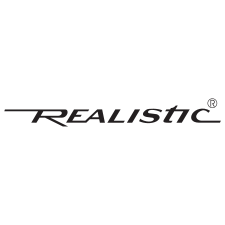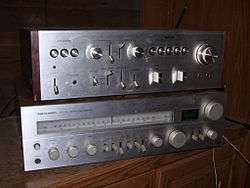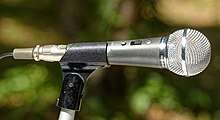Realistic (brand)
Realistic is a brand produced by RadioShack, a division of Tandy Corporation, to market audio and video products for home use. The brand name was phased out in the mid 1990s and discontinued in 2000, then returned briefly in 2016.
 | |
| Industry | Electronics |
|---|---|
| Fate | Renamed Radio Shack brands |
| Founded | 1969 |
| Defunct | 2000 (Returned in 2016) |
| Products | Record players, Audio receivers, Cassette decks, Ham radios, Speakers |
History
The brand began in 1954 under the name realist, but was subsequently changed due to a prior camera trademark, Stereo Realist.[1] The company's most notable products under the Realistic brand included the extensive line of TRC series Citizens Band radio transceivers, which dominated the CB Radio market during the 1970s, and included the Navaho series of CB base station units. A 1977 motion picture entitled Handle with Care was sponsored at the time by Tandy Corporation, in part to showcase the line. Also notable were their 8-track tape recorders under the TR- model line and their compact cassette decks under the SCT- model line. They are also the company responsible for the Realistic Mach speaker line. A very wide range of products was marketed under the Realistic brand. These included record players, stereo receivers, cassette decks, ham radios,[2] musical synthesizers and a few quadraphonic receivers and shortwave radios.
Optimus
In the early 1990s, the Realistic brand began to change its name to Optimus, a brand of speakers RadioShack had been offering since the 1970s. Both Realistic and Optimus brand names were retired in 2000 after RadioShack entered an agreement with RCA to market their products.[3]
Realistic enjoyed a short-lived return to RadioShack's stores in 2016 with a line of wireless bluetooth speakers and wireless noise-canceling bluetooth headphones.
Models
The Realistic DX-60 is an AM-mode only device. The radio receives 3 MHz to 27 MHz AM shortwave in three bands, 26.965 MHz through 27.405 MHz HF CB in one band, 540 kHz to 1620 kHz standard AM broadcast in one band, and 87 MHz to 108 MHz monaural standard broadcast FM. The radio existed in two versions, model 12-764 and a nearly identical but production-cost-reduced 12-764A.
.jpg) Realistic 8 Transistor Radio, Circa 1959
Realistic 8 Transistor Radio, Circa 1959 Realistic STA-240 receiver with a Nikko TRM-800 amplifier
Realistic STA-240 receiver with a Nikko TRM-800 amplifier.jpg) Realistic stereo mixing console
Realistic stereo mixing console Shure 588SD microphone, branded as Realistic Highball, circa 1970
Shure 588SD microphone, branded as Realistic Highball, circa 1970
References
- "Company Profile". antiqueradio.com.
- "Technical Information on Radio Shack, Archer, Micronta and Realistic Equipment". www.repeater-builder.com. Retrieved 21 July 2015.
- "Tandy to Replace House Brands With RCA," The Associated Press, Friday, May 14, 1999.
External links
| Wikimedia Commons has media related to Realistic (brand). |
- RadioShack / Realistic Catalog Archive (1939-2005)
- "Realistic". audiocircuit.com.